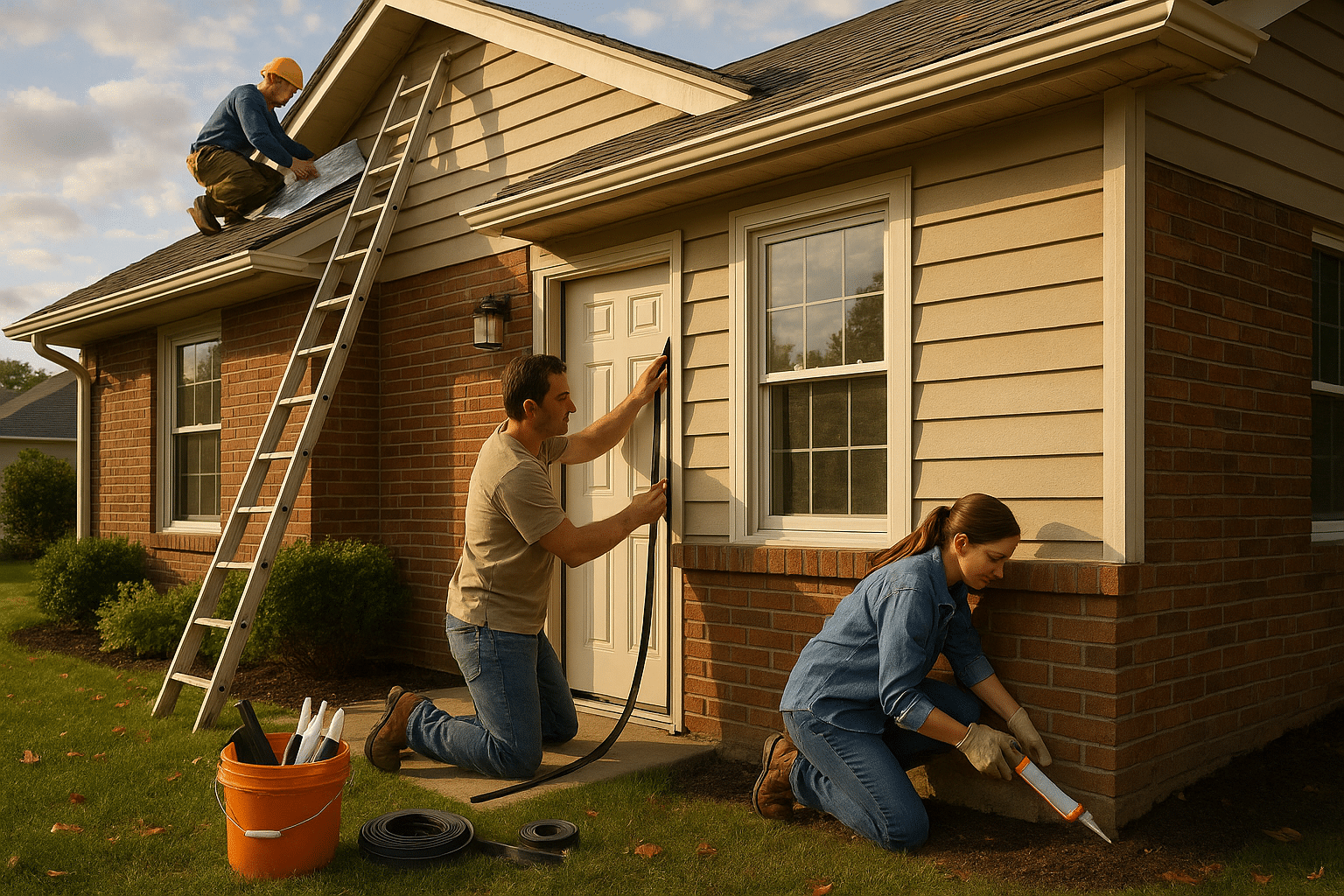In this era of high energy costs and environmental concerns, weatherproofing your home can make a significant difference. However, hiring professionals can often be a costly endeavor. The good news is that with a bit of grit, a few tools, and the right knowledge, you can weatherproof your home yourself, save on energy bills, and contribute to a sustainable future. Welcome to the realm of DIY weatherproofing.
The advantages of DIY weatherproofing are multi-faceted. It not only reduces energy consumption but also enhances the comfort of your home. In this in-depth blog post, we will be focusing on simple yet effective DIY hacks that can help you weatherproof your home, save money, and decrease your carbon footprint.🌳
Why Consider DIY Weatherproofing?
While the motivation for weatherproofing may vary from person to person, the most common reasons are to reduce energy consumption, save money, and contribute to environmental sustainability. Given the rising costs of energy, weatherproofing can make your home more energy-efficient, saving you money in the long run. Additionally, by reducing your energy use, you are indirectly reducing greenhouse gas emissions, contributing to the fight against climate change.
DIY weatherproofing has the added advantage of being cost-effective. It is also a practical way of learning about the nuances of your home and understanding how best to optimize its energy use. You don’t need to be a seasoned handyman or woman to weatherproof your home. With a little patience and the right guidance, anyone can do it. 🏠💡
What’s Ahead?
In this comprehensive guide, we will walk you through a range of DIY weatherproofing techniques to improve the energy efficiency of your home. The first part of this guide will focus on understanding the basic concept of weatherproofing, its importance, and how it works. We will then delve into the various weatherproofing methods, discussing the practical aspects of each.
The second part of this guide will be dedicated to DIY weatherproofing hacks that you can implement at home. These will range from simple tasks like sealing cracks and drafts to more complex projects like installing insulation or energy-efficient windows.
By the end of this guide, you should have a good understanding of how to weatherproof your home and the potential savings it can bring. We will also discuss the environmental benefits of weatherproofing and how you can contribute to a sustainable future. 🌍💰
Understanding Your Home
Before you start weatherproofing your home, it’s essential to understand how your home uses energy. The places where heat is typically lost are through the roof, windows, doors, walls, and floor. By understanding this, you can prioritize your weatherproofing tasks effectively.
While we will be discussing various methods and hacks, remember that what works best for your home may not work for someone else’s. The best approach to DIY weatherproofing is to understand your home’s specific needs and plan accordingly.
Ready to dive in? Let’s embark on this journey of cost-saving, energy-efficient living together. Grab your toolbox, and let’s get started! 🔧🔨
Unlocking the Power of DIY Weatherproofing: Your Key to Energy and Cost Efficiency
With energy costs spiraling out of control, there is a need to look for ingenious ways to save on your energy bill. DIY weatherproofing is one of those simple but effective strategies that you can use to lower your energy use and, consequently, your energy bills. This article delves into the ins and outs of DIY weatherproofing, highlighting easy hacks you can implement to reduce energy use and save money.
Weatherproofing your home is essentially about sealing air leaks around your home and adding insulation to prevent heat loss during winter and heat gain during summer. When done correctly, weatherproofing can save you up to 20% on your heating and cooling costs. This not only translates to huge savings on your energy bills, but it also means less reliance on non-renewable sources of energy, thereby reducing your carbon footprint.
Let’s get started on this journey to energy efficiency, cost savings, and environmental conservation. Get your toolbox ready, and watch the video “How to Weatherproof Your Home – Top Tips and Techniques” by DIY Pete to get a visual guide on how to go about this.
The Anatomy of a Well-Weatherproofed Home: Key Areas to Focus on
Weatherproofing your home involves a holistic approach that covers all areas of your home. This includes the exterior walls, roof, windows, doors, and the foundation. Each of these areas requires a different approach and materials for effective weatherproofing. However, the ultimate goal is the same – to prevent air leaks and heat loss/gain.
Let’s take a closer look at these key areas:
Exterior Walls and Roof
Your exterior walls and roof are the first line of defense against outdoor weather elements. Insulating these areas helps keep the cold air out during winter and hot air out during summer. You can use materials such as spray foam, fiberglass batts, or cellulose for this purpose. Remember to seal any air leaks with caulk or weatherstripping before insulating.
Windows and Doors
Windows and doors are notorious for air leaks. Caulking and weatherstripping are two simple and cost-effective methods to seal these leaks. For windows, you can also use window film to provide an extra layer of insulation. For doors, consider using door sweeps to prevent air leakage from the bottom of the door.
Foundation
Finally, don’t forget about your foundation. Cracks and gaps in the foundation can lead to air leaks and water damage. Use a concrete crack filler to seal these cracks and protect your home from moisture and pests.
Now, let’s compare the effectiveness of different weatherproofing materials. The following table shows a comparison of common weatherproofing materials, their cost, and energy savings.
| Material | Cost | Energy Savings |
|---|---|---|
| Spray Foam | Moderate | High |
| Fiberglass Batts | Low | Medium |
| Cellulose | Low | Medium |
| Caulk | Low | Medium |
| Weatherstripping | Low | Medium |
DIY Weatherproofing Hacks: Your Guide to Cost Savings and Energy Efficiency
Now that you understand the key areas to focus on for weatherproofing your home and the materials you’ll need, it’s time to dive into the practical aspect. Here are some easy DIY weatherproofing hacks you can implement to cut costs and save energy.
Firstly, conduct a home energy audit to identify areas of energy wastage. You can do this yourself or hire a professional. A home energy audit will help you prioritize your weatherproofing efforts based on the energy savings potential of each area of your home.
Secondly, seal air leaks around your home. As mentioned earlier, air leaks can significantly increase your heating and cooling costs. Use caulk, weatherstripping, or spray foam to seal these leaks.
Thirdly, insulate your home. This involves adding insulation to your walls, roof, and foundation. Remember, the type of insulation you choose depends on the specific needs of each area of your home. Check out the video “DIY Home Insulation – How to Insulate Your Home on a Budget” by DIY Creators for more insights on this.
Wrapping Up: Maintaining Your Weatherproofed Home
Maintaining a well-weatherproofed home is not a one-time event but a continuous process. Regular inspections and repairs are necessary to ensure your weatherproofing measures are effective. Ensure to check your insulation regularly, especially after extreme weather conditions, and replace it when necessary.
Regularly clean and maintain your heating and cooling systems to ensure they are operating at maximum efficiency. A poorly maintained HVAC system can undermine your weatherproofing efforts, leading to higher energy costs.
Remember, DIY weatherproofing is not just about saving money and energy; it’s also about creating a comfortable and healthy living environment for you and your family. So, roll up your sleeves and get started on your DIY weatherproofing project today. Every small effort counts towards a more energy-efficient and cost-effective home.

Conclusion
In conclusion, this comprehensive journey through the terrain of IT and Engineering is one that has hopefully shed light on the intricate nuances and the fundamental pillars that underpin these domains. By delving into the technicalities of software engineering, the relevance of IT, and the synergistic interplay between the two, we have embarked on a quest to unravel the mysteries that they hold, a pursuit that may have seemed daunting initially but has now come to fruition.
The importance of understanding software engineering cannot be overemphasized. As we highlighted, it is the bedrock of designing, developing, and maintaining software systems. Its principles guide the creation of software that is reliable, efficient, and effective, meeting the dynamic needs of the ever-evolving technological landscape. Be it the waterfall model or the agile methodology, the role of software engineering in shaping our digital world is undeniable.
Simultaneously, our exploration of IT – a realm that transcends traditional boundaries of communication, data processing, and business operations – has hopefully elucidated its undeniable significance. From the way it has redefined workplaces to its pivotal role in global connectivity, IT has truly become the backbone of the modern world.
The marriage of IT and Engineering is where the magic truly happens. Together, they conjure a symbiotic relationship that propels innovation, fosters creativity, and enables the creation of solutions that truly shape the world. We have tried to elucidate this symbiosis, hoping to instill an appreciation for the depth and breadth of their confluence.
In our quest for understanding, we have leaned heavily on reliable sources such as the Institute of Electrical and Electronics Engineers (IEEE) [1] and the Association for Computing Machinery (ACM) [2]. We encourage you to delve deeper into these resources, seeking to further enrich your knowledge and satiate your intellectual curiosity.
Before we conclude, a word on the importance of continued learning and exploration. As the world of IT and Engineering continues to evolve at a breakneck pace, staying abreast of the latest developments and trends is crucial. In this regard, we believe in the power of shared knowledge and learning. Therefore, we urge you to comment below, sharing your insights, questions, and perspectives. The more we learn together, the greater our collective understanding. 🧠
We also encourage you to share this article with your colleagues, peers, and anyone who might benefit from this knowledge. Let’s spread the word, fostering a community of learners and practitioners who are passionate about IT and Engineering. 🔗
As we part ways, remember that the journey of learning never truly ends. As Albert Einstein once said, “Once you stop learning, you start dying.” So, let’s keep learning, keep growing, and keep pushing the boundaries of our understanding. Until next time, happy learning! 🚀
Sources:
[1] Institute of Electrical and Electronics Engineers (IEEE)
[2] Association for Computing Machinery (ACM)



